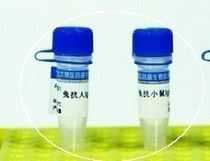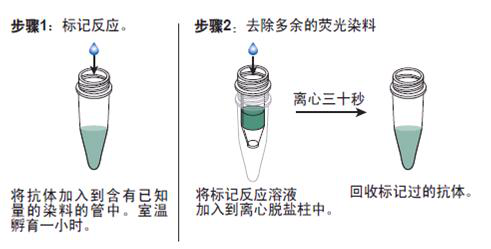
|

| 产地 | 进口、国产 |
| 品牌 | 上海莼试 |
| 保存条件 | Store at -20 °C |
| 货号 | CS10076 |
| 应用范围 | WB=1:100-500 ELISA=1:500-1000 IHC-P=1:100-500 IHC-F=1:100-500 ICC=1:100-500 IF=1:100-500 |
| CAS编号 | |
| 抗体名 | Anti-Orexin B |
| 克隆性 | |
| 靶点 | 详见说明书 |
| 适应物种 | 详见说明书 |
| 形态 | 详见说明书 |
| 宿主 | 详见说明书 |
| 亚型 | IgG |
| 标识物 | 详见说明书 |
| 浓度 | 1mg/1ml% |
| 免疫原 | KLH conjugated synthetic peptide derived from human Orexin B |
产品订购信息:
英文名称 Anti-Orexin B
中文名称 增食欲素B/欲激素B说明书
别 名 HCRT; Hcrt2; Orexin 2; Orexin-2; hypocretin (orexin) neuropeptide precursor; Hypocretin 2; hypocretin; NRCLP1; Orexin; Orexin precursor; OX; PPOX; prepro orexin; OREX_HUMAN; PPORX.


浓 度 1mg/1ml
规 格 0.1ml/100μg 0.2ml/200μg
抗体来源 Rabbit
克隆类型 polyclonal
交叉反应 Human, Dog, Pig, Cow, Rabbit, Sheep
产品类型 一抗
研究领域 细胞生物 免疫学 神经生物学
蛋白分子量 predicted molecular weight: 3kDa
性 状 Lyophilized or Liquid
免 疫 原 KLH conjugated synthetic peptide derived from human Orexin B
亚 型 IgG
纯化方法 affinity purified by Protein A
储 存 液 Preservative: 15mM Sodium Azide, Constituents: 1% BSA, 0.01M PBS, pH 7.4
增食欲素B/欲激素B说明书 产品应用 WB=1:100-500 ELISA=1:500-1000 IHC-P=1:100-500 IHC-F=1:100-500 ICC=1:100-500 IF=1:100-500
(石蜡切片需做抗原修复)
not yet tested in other applications.
optimal dilutions/concentrations should be determined by the end user.
保存条件 Store at -20 °C for one year. Avoid repeated freeze/thaw cycles. The lyophilized antibody is stable at room temperature for at least one month and for greater than a year when kept at -20°C. When reconstituted in sterile pH 7.4 0.01M PBS or diluent of antibody the antibody is stable for at least two weeks at 2-4 °C.
Important Note This product as supplied is intended for research use only, not for use in human, therapeutic or diagnostic applications.
产品介绍 The hypothalamus acts as a major regulatory center involved in the control of feeding behavior and energy homeostasis. Several neuropeptides and proteins have been shown to be involved in the regulation of these processes. Orexin A (hypocretin 1) a 33 amino acid peptide and orexin B(hypocretin 2), a 28 amino acid peptide, are both derived from a common 130 amino acid precursor, prepro-orexin, which is encoded by a gene localized to human chromosome 17q21. Orexin A and Orexin B stimulate food consumption when administered intracerebroventricularly to rats. Orexin gene expression in the brain is highly restricted to distinct populations of neurons located in specific hypothalamic regions, including the lateral hypothalamic area (LHA), a region implicated in feeding behavior.
Function : Neuropeptides that play a significant role in the regulation of food intake and sleep-wakefulness, possibly by coordinating the complex behavioral and physiologic responses of these complementary homeostatic functions. A broader role in the homeostatic regulation of energy metabolism, autonomic function, hormonal balance and the regulation of body fluids, is also suggested. Orexin-A binds to both OX1R and OX2R with a high affinity, whereas orexin-B binds only to OX2R with a similar high affinity.
Subcellular Location : Associated with perikaryal rough endoplasmic reticulum as well as cytoplasmic large granular vesicles at synapses.
Post-translational modifications : Specific enzymatic cleavages at paired basic residues yield the different active peptides.
DISEASE : Defects in HCRT are the cause of narcolepsy type 1 (NRCLP1) [MIM:161400]. Narcolepsy is a neurological disabling sleep disorder, characterized by excessive daytime sleepiness, sleep fragmentation, symptoms of abnormal rapid-eye-movement (REM) sleep, such as cataplexy, hypnagogic hallucinations, and sleep paralysis. Cataplexy is a sudden loss of muscle tone triggered by emotions, which is the most valuable clinical feature used to diagnose narcolepsy. Human narcolepsy is primarily a sporadically occurring disorder but familial clustering has been observed. Note=Human narcolepsy is associated with a deficient orexin system. Orexins are absent and/or greatly diminished in the brain and cerebrospinal fluid (CSF) of most narcoleptic patients.
Similarity : Belongs to the orexin family.
Database links : UniProtKB/Swiss-Prot: O43612.1

Anti-Caspase-6 (NT)/FITC 荧光素标记半胱胺酸蛋白酶蛋白-6抗体(N端)IgGMulti-class antibodies规格: 0.2ml
Anti-HA tag/HRP 辣根过氧化物酶标记HA tag标签抗体IgGMulti-class antibodies规格: 0.2ml
Rhesus antibody Rh CG6856/CG6856-PA 果蝇CG6856-PA抗体 规格 0.5ml
TRAF2/TNF-R2 (TNF receptor-associated factor 2) 坏死因子受体相关因子2抗原 0.5ml
IL-4 英文名称: 白介素4抗体 0.1ml
Rhesus antibody Rh TLR9/CD289 Toll样受体9抗体 规格 0.1ml
Anti-HA tag/HRP 辣根过氧化物酶标记HA tag标签抗体IgGMulti-class antibodies规格: 0.2ml
human PL-A2 (phospholipase A2) 人磷脂酶A2Multi-class antibodies规格: 48T
Anti-ChRM3 毒蕈碱型乙酰胆碱受体M3抗体Multi-class antibodies规格: 0.1ml
Rhesus antibody Rh NUBP2 核苷酸结合蛋白2抗体 规格 0.2ml
TRIquick 总RNA提取试剂 20ml
Tomosyn/STXBP5 英文名称: 突触融合蛋白结合蛋白5抗体 0.2ml
CNOT2 英文名称: 细胞表面趋化因子受体4相关蛋白2抗体 0.2ml
Anti-ChRM3 毒蕈碱型乙酰胆碱受体M3抗体Multi-class antibodies规格: 0.1ml
phospho-AKT1/PKB1/2/3(pThr473)peptide 磷酸化蛋白激酶B抗原(丝氨酸磷酸化位点:473)Multi-class antibodies规格: 0.5mg
Anti-Aurora B 有丝分裂激酶B抗体Multi-class antibodies规格: 0.2ml
Rhesus antibody Rh phospho-AKT/PKB(Ser473) 磷酸化蛋白激酶B抗体 规格 0.1ml
Mesothelin(1:60) 间皮瘤 浓缩液 0.1ml 进口分装
UNC5C 英文名称: 神经突起生长诱导因子受体UNC5B抗体 0.2ml
DYNC1I1 英文名称: 胞浆动力蛋白中间链1抗体 0.1ml
Anti-Aurora B 有丝分裂激酶B抗体Multi-class antibodies规格: 0.2ml
HGF Protein Cynomolgus 重组食蟹猴 HGF / Hepatocyte Growth Factor 蛋白
KG-1 人髓性红细胞
ULBP2 Others Human 人 ULBP2 / N2DL-2 人细胞裂解液 (阳性对照)
HeLa 229人细胞 HeLa 229 human cervical cancer cells RPMI-1640(GIBCO)+10%FBS
中国仓鼠肺细胞;R 1610 [R1610]
小鼠周神经成纤维细胞(MPNF)(5×105) HL-60, 人早幼粒细胞 Human
CL-0336FC33(人胚胎肾细胞(Asp-2基因修饰))5×106cells/瓶×2
CS Others Human 人 Ciate syhase / CS 杆状病毒-昆虫细胞裂解液 (阳性对照)
人肠平滑肌细胞总RNAHISMC NA
山羊皮肤细胞;WGS1 大鼠心肌细胞,H9c2细胞 Ca759细胞,615小鼠株
人胚胎成纤维样细胞;HEH2
HA Others H1N2 甲型 H1N2 (A/swine/Guangxi/13/2006) 血凝素HA1 (Hemagglutinin) 人细胞裂解液 (阳性对照)
增食欲素B/欲激素B说明书 HGF Protein Cynomolgus 重组食蟹猴 HGF / Hepatocyte Growth Factor 蛋白
KG-1 人髓性红细胞
ULBP2 Others Human 人 ULBP2 / N2DL-2 人细胞裂解液 (阳性对照)
HeLa 229人细胞 HeLa 229 human cervical cancer cells RPMI-1640(GIBCO)+10%FBS
中国仓鼠肺细胞;R 1610 [R1610]
小鼠周神经成纤维细胞(MPNF)(5×105) HL-60, 人早幼粒细胞 Human

抗体的生物素化标记实验要点:
1. 增食欲素B/欲激素B说明书 如在反应混合液中有叠氮钠或游离氨基存在,会抑制标记反应。因此,蛋白质在反应前要对 0.1mol/L碳酸氢钠缓冲液或0.5mol/L硼酸缓冲液充分透析;
2.所用的NHSB及待生物素化蛋白质之间的分子比按蛋白质表面的ε-氨基的密度会有所不同,选择不当则影响标记的效率,应先用几个不同的分子比来筛选最适条件;
3.用NHSB量过量也是不利的,抗原的结合位点可能因此被封闭,导致抗体失活;
4.由于抗体的氨基不易接近可能造成生物素化不足,此时可加入去污剂如 Triton x-100, Tween20等;
5.当游离ε-氨基(赖氨酸残基的氨基)存在于抗体的抗原结合位点时,或位于酶的催化位点时,生物素化会降低或损伤抗体蛋白的结合力或活性;
6.生物素还可能与不同的功能基团,如羰基、氨基、巯基、异咪唑基及*基,也可与糖基共价结合;
7.交联反应后,应充分透析,否则,残余的生物素会对生物素化抗体与亲和素的结合产生竞争作用;
8.在细胞的荧光标记实验中,中和亲和素的本底低,但由于链霉亲和素含有少量正电荷,故对某些细胞可导致高本底。
抗体的鉴定:
1)增食欲素B/欲激素B说明书 抗体的效价鉴定:不管是用于诊断还是用于,制备抗体的目的都是要求较高效价。不同的抗原制备的抗体,要求的效价不一。鉴定效价的方法很多,包括有试管凝集反应,琼脂扩散试验,酶联免疫吸附试验等。常用的抗原所制备的抗体一般都有约成的鉴定效价的方法,以资比较。如制备抗抗体的效价,一般就采用琼脂扩散试验来鉴定。
2)抗体的特异性鉴定:抗体的特异性是指与相应抗原或近似抗原物质的识别能力。抗体的特异性高,它的识别能力就强。衡量特异性通常以交叉反应率来表示。交叉反应率可用竞争抑制试验测定。以不同浓度抗原和近似抗原分别做竞争抑制曲线,计算各自的结合率,求出各自在IC50时的浓度,并按公式计算交叉反应率。
如果所用抗原浓度IC50浓度为pg/管,而一些近似抗原物质的IC50浓度几乎是无穷大时,表示这一抗血清与其他抗原物质的交叉反应率近似为0,即该血清的特异性较好。
3)抗体亲和力:是指抗体和抗原结合的牢固程度。亲和力的高低是由抗原分子的大小,抗体分子的结合位点与抗原决定簇之间立体构型的合适度决定的。有助于维持抗原抗体复合物稳定的分子间力有氢键,疏水键,侧链相反电荷基因的库仑力,范德华力和空间斥力。亲和力常以亲和常数K表示,K的单位是L/mol。抗体亲和力的测定对抗体的筛选,确定抗体的用途,验证抗体的均一性等均有重要意义。